The Leopard Danio is a freshwater fish in the Cyprinidae family. They are a captive-bred variety of the zebra danio. It is native to India, Pakistan, Bangladesh, Nepal, and Bhutan. Francis Hamilton first described it in 1822. The Leopard Danio has an elongated body with dark spots on a gold or silver background.
The belly is white. The males are smaller than the females and have brighter colors.
The Leopard Danio is a popular aquarium fish. It is easy to care for and can live in various water conditions. The diet should include live, frozen, and flake foods. The Leopard Danio is a peaceful fish and can be kept with other delicate fish.
They are called ‘jumpy fish’ because they are constantly in motion, even resting. They have a very high metabolism and require a lot of oxygen. The origin of these fishes is a mystery. There are many different stories about how they came to be. One report says that a mutation created them in the wild.
Another story says they were created by crossing two different fish species. Other aquarists say the Leopard Danio was made from the dwarf danio or spotted danio. Whatever the case, Leopard Danios are a beautiful and popular fish that are here to stay!
Table of Contents
Species Summary
| Scientific name: | Danio rerio |
| Common names: | Spotted danio or longfin spotted danio, Zebrafish |
| Size: | 2.25–2.5 inches |
| Life expectancy: | 3–4 years |
| Color: | Brown-gold color with blue-gray spots |
| Diet: | Omnivorous |
| Temperament: | Peaceful |
| Minimum tank size: | 10-20 gallons |
| Temperature: | 64°–75°F (18–24°C) |
| pH: | 6.0–8.0 |
| Hardness: | 2–20 dGH |
| Care Level: | Easy |
| Water Type: | Freshwater |
| Origin: | India, Pakistan, Bangladesh, Nepal, and Bhutan |
| Breeding: | Lays eggs that are fertilized externally |
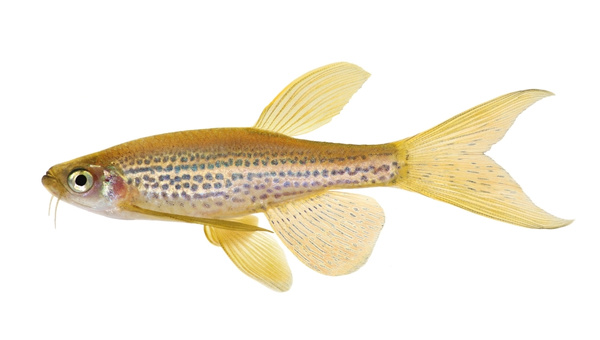
Leopard Danios are widely available and easy to find. They can be bought online or at your local fish store. The price for one Leopard Danio ranges from $2 to $5.
Leopard Danios Appearance
Leopard Danios have an elongated and laterally compressed body. They are brown-gold with blue-gray spots. The belly is white.
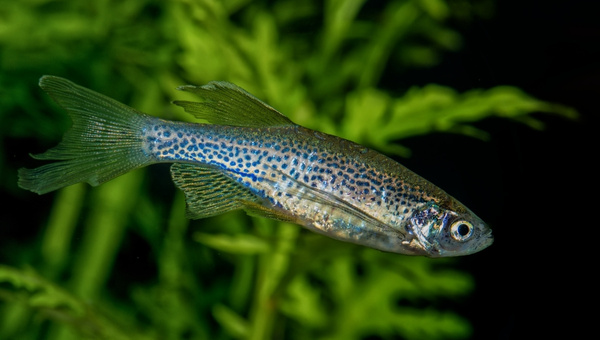
Males are smaller than females and have brighter colors. Female Leopard Danios have a chubby body shape than males. They have long fins that extend the length of their bodies.
The dorsal fin has 11-12 rays, and the anal fin has 5-6. They have long, pointed heads with small eyes. They have a barbell on each side of their mouth. The longfin variety of the Leopard Danio has a long tail and long, flowing fins. They have 12-14 gill rakers. They can grow to be about 2.5 inches (6.4 cm) long.
Check Panther Grouper Care Guide: Appearance, Lifespan & Coloration & Breeding
Leopard Danios Size and Growth Rate
The Leopard Danio grows to be about 2.5″ long at full maturity.
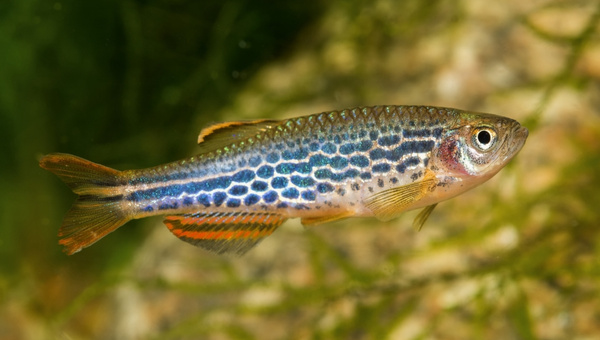
They are fast-growing fish, so expect them to reach their full size within the first year or two of life.
Check the 12 Most Popular Types Of Danios: Appearance, Care, LIfespan & All
Leopard Danios Lifespan
The lifespan of a Leopard Danio is around 3 to 4 years in captivity. However, some Leopard Danios have been known to live up to 8 years with proper care.
Also, check Celestial Pearl Danio 101: Best Care Guide
Leopard Danios Temperament and Behavior
Leopard Danios are peaceful, active fish that greatly add to any community aquarium. They are particularly well-suited for planted tanks and will not uproot or eat most aquatic plants. Leopard Danios are also compatible with many other small, peaceful fish.
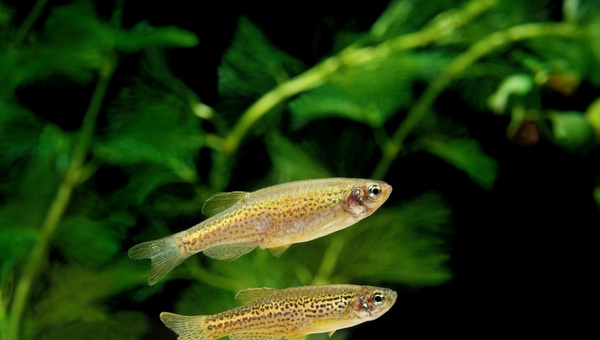
These Danios are fun to watch as they constantly swim back and forth in the aquarium.
Leopard Danios are not known to be fin nippers but can sometimes harass slower-moving or long-finned fish. They should not be kept with larger, more aggressive fish that may view them as food.
Leopard Danios Breeding
Leopard Danio is easy to breed in an aquarium setup with a few simple steps. You first need to find a male and female that you feel comfortable with and have them both in the tank. You will also need to ensure the water is clean and has the proper pH level for breeding.
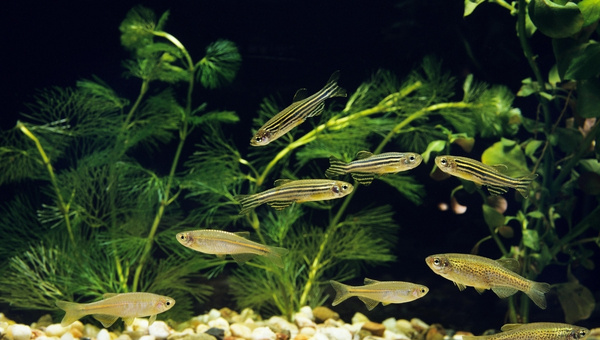
Once you have this setup, you can start the process by introducing the male to the female. The male will then chase the female around and eventually catch her. Once he has done this, he will wrap his body around hers, and they will sink to the bottom of the tank. At this point, the eggs will be released and fertilized.
The female will lay the eggs on a plant or driftwood in the tank. Once the eggs have been laid, you will need to remove the parents from the tank, so they do not eat them. The eggs will hatch in about 24-48 hours, and the fry will be free-swimming a few days later.
You can feed the live fry food or baby brine shrimp until they are big enough to eat regular food.
Leopard Danios Care Guide
These fishes are easy to care for and make a great addition to any freshwater aquarium. They are peaceful fish and can be kept with other peaceful fish.
They do best in an aquarium of at least 10 gallons (38 L). The water should be kept at 64° to 75°F (18° to 24°C) with a pH of 6.0 to 8.0 and a hardness of 2 to 20 dGH. The Leopard Danio likes to swim in medium- to fast-moving water, so create a water current in the tank with a water pump.
They are omnivorous, and their diet should include live, frozen, and flake foods. To help with their digestion, they should be given a pea or piece of lettuce once a week.
Leopard Danios Tank Size
The minimum tank size for a Leopard Danio is 10 gallons which is 38L. A good rule of thumb is to add an extra 1-2 gallons (4-8L) of water for each Leopard Danio in your tank because they are very active fish.
The still-water bodies where these fishes feed and spawn have silty sand and dense vegetation, while the fast-moving rivers and streams where they swim are clear, rocky, and shaded. Mimic this environment in the Leopard Danio’s tank.
Water Parameters
The water parameters for Leopard Danios are pretty straightforward. They prefer neutral to slightly alkaline water with a temperature range of 65° to 75°Fahrenheit. The tank should be at least 10 gallons, but 20 gallons is ideal.
Set up your tank for the Leopard Danio according to these conditions:
- Water type: Freshwater
- Tank size: Minimum 10 gallons, but 20 gallons is preferred
- Water temperature: 65° to 75°F
- Substrate: Sand or dark, fine gravel
- Tank setup: Plants
- Acidity: 6.0 to 8.0 pH
- Water hardness: 2 to 20 dGH
- Filter: Yes, to help keep the tank’s water clean and remove debris, nitrates, and ammonia
- Water movement: Yes, to help keep the tank’s water clean and remove debris, nitrates, and ammonia
- Lighting: Subdued or moderate/standard lighting
It is recommended to replace 20%–25% of the water weekly or every second week. Plenty of open water should be from the middle to the top of the tank so Leopard Danios have enough space to swim.
These little guys are known to be jumpers, so a lid is recommended. They are also quite active and love to swim in groups, so a larger tank is better than a small one. Leopard Danios are not picky eaters and will accept most aquarium foods.
You may also check Freshwater Flounder Care Guide: Appearance, Diet, Breeding & All.
Filtration
Along with a good quality diet, filtration is one of the most important things you can do to keep your Leopard Danio healthy. Leopard Danios are relatively small fish and produce a fair amount of waste. A good filter will help to remove debris and waste from the water and keep the water quality high.
There are a variety of filters available on the market, so it is essential to choose one that is appropriate for the size of your aquarium and the number of fish you have.
Following are some commonly recommended filters for Leopard Danio:
- Aquarium Sponge Filter: These filters are trendy among fishkeepers because they are easy to use and maintain. They are also relatively inexpensive. Sponge filters provide mechanical and biological filtration and can be used in fresh and saltwater aquariums.
- Hang on Back (HOB) Filter: These filters are also popular among fish keepers. They are easy to install and maintain and come in various sizes to suit different-sized aquariums. HOB filters provide both mechanical and biological filtration.
- Canister Filter: Canister filters are less common than other filters but are very effective at filtering water. They are, however, more expensive than different types of filters and can be challenging to set up and maintain. Canister filters provide both mechanical and biological filtration.
In addition to using a filter, it is also essential to do regular water changes. Water changes help to remove debris and waste from the water and keep the water quality high. A water change of 10-15% is recommended once a week.
Also, check Sand Sifting Starfish 101: Care, Appearance, Lifespan, Diet & All
Heating
Leopard Danios are tropical fish and need warm water to thrive. The ideal water temperature for Leopard Danios is between 65° to 75°F. If the water in your aquarium is more excellent than this, you will need to use a heater to raise the temperature.
There are a variety of heaters available on the market. Choosing a heater that is appropriate for the size of your aquarium is essential.
Following are some commonly recommended heaters for Leopard Danio:
- Aqueon Aquarium Heater: This is popular among fishkeepers because it is easy to use and comes in various sizes to suit different-sized aquariums.
- Eheim Jager Aquarium Heater: This heater is also popular among fish keepers. It is easy to use and comes in various sizes to suit different-sized aquariums.
- Fluval E Series Heater: This heater is less common than other heaters, but it is very effective at heating water. It is, however, more expensive than different types of heaters.
It is also essential to choose a heater with an automatic shut-off feature. This feature will turn the heater off if the water temperature gets too high.
Also, check Cherry Shrimp Care Guide: Appearance, Food & Diet, Lifespan & All
Water Quality
Keeping the water in your aquarium clean is essential for the health of your Leopard Danio. A sound filtration system will help to remove debris and waste from the water and keep the water quality high. It is also essential to do regular water changes.
Water changes help to remove debris and waste from the water and keep the water quality high. A water change of 20-25% is recommended once a week.
In addition to using a filter and doing regular water changes, it is also essential to regularly test the water in your aquarium. Testing the water will help you keep track of the water quality and ensure that the levels of ammonia, nitrites, and nitrates are within the safe range.
There are a variety of water test kits available on the market. Choosing a test kit appropriate for the size of your aquarium and the number of fish you have is essential.
Following are some commonly recommended water test kits for Leopard Danio:
- API Freshwater Master Test Kit: This test kit is popular among fishkeepers because it is easy to use and comes with everything you need to test the water in your aquarium.
- Tetra Easy Strips 6-in-1 Aquarium Test Strips: These test strips are also popular among fish keepers. They are easy to use and provide accurate results.
- Salifert Test Kit: This test kit is less standard than other test kits but is very accurate. It is, however, more expensive than different types of test kits.
You may also check Rosy Barb 101: Care, Species, Appearance, Tankmates, Habitat & All
Plants
Leopard Danios are not picky eaters and will generally eat any plant. However, a few plants are known to be particularly enjoyed by Leopard Danios.
Some of the most popular plants for Leopard Danios include:
- Anacharis
- Hornwort
- Java Fern
Substrate
Leopard Danios are not particularly picky about the type of substrate you use in your aquarium. However, a few substrates are known to be particularly enjoyed by Leopard Danios.
Some of the most popular substrates for Leopard Danios include:
- Gravel
- Sand
- Coconut fiber
Also, check Cherry Barb Fish: Care, Tankmates, Lifespan, Breeding & All
Lightening
Leopard Danios are comfortable in various lighting conditions, from low to high. However, they do best in moderate to bright light. If the light is too low, they may lose their coloration and become drabber; if it is too bright, they may become stressed.
Following are some excellent recommended lightening options for your Leopard Danio fish tank:
- Fluorescent Tubes: This good, all-around lighting option will provide moderate to bright light, depending on your tube type. You can also get tubes that emit different color temperatures, so you can choose one that complements your fish’s color.
- LED Lights: LED lights are becoming increasingly popular for fish tanks because they are energy-efficient and long-lasting. They come in various colors, so you can choose one that will make your fish look their best.
- Metal Halide Lights: These lights are very bright and should be used cautiously, as they can stress out your fish if they are not accustomed to them. If you choose to use metal halide lights, it is best to gradually increase the time they are on each day so that your fish can get used to the change.
Check Black Neon Tetra 101: Best Care Guide, Species Summary & All
Cleaning The Tank
You should perform a partial water change of 25% every other week. You will also need to vacuum the gravel and clean the filter media. Rinse the filter media in old tank water to prevent disrupting the beneficial bacteria colony.
To clean the tank, you will need the following:
- A sponge: A sponge can be used to wipe down the inside of the tank.
- A toothbrush: A toothbrush can be used to clean the filter.
- Freshwater: You will need fresh water to rinse off the sponge and toothbrush.
The steps for cleaning the tank are as follows:
- Remove the fish from the tank and put them in a temporary home.
- Remove all of the decorations from the tank.
- Use the sponge to wipe down the inside of the tank.
- Rinse the sponge and toothbrush with fresh water.
- Use the toothbrush to clean the filter.
- Rinse the sponge and toothbrush with fresh water.
- Add the decorations back to the tank.
- Add the fish back to the tank.
It is essential to clean the tank regularly to prevent the build-up of algae and bacteria. Algae and bacteria can be harmful to fish, and they can also cause the water to become cloudy.
Cleaning The Filter
It is essential to clean your filter regularly. A dirty filter can cause problems for your fish.
To clean your filter, you will need the following:
- A clean bucket: This is used to hold the old water.
- A garden hose: This is used to rinse the filter media.
- Filter media: This is used to replace the old media.
To start, you will need to remove the filter from your tank. Then, use the clean bucket to hold the old water.
Next, use the garden hose to rinse the filter media.
Finally, replace the old media with new media.
You may also check White Cloud Mountain Minnow 101: Species Summary & Detailed Care Guide
Common Possible Diseases
Leopard Danios are prone to the same diseases that other fish are susceptible to. Some of these diseases include:
- Ich: This is a common disease that can affect any fish and is characterized by white spots on the body. It is caused by a parasite that enters the fish’s body through its gills.
- Columnaris: This is another common disease that can affect any fish. White spots or patches on the body, fins, and tail characterize it. It is caused by bacteria that enter the fish’s body through open wounds.
- Velvet: This disease is characterized by a velvet-like coating on the body. It is caused by a parasite that enters the fish’s body through its gills.
These are just a few diseases that Leopard Danios can get. It is essential to be aware of these diseases to treat your fish if they become affected quickly.
Also, check Cardinal Tetra 101: Species Summary & Ultimate Care Guide
Prevention and Medications of diseases
The best way to prevent diseases is to quarantine new fish before adding them to your main tank. You should also regularly clean your tank and remove any decaying matter. Finally, feeding your fish a high-quality diet would boost their immune system.
There are a variety of medications that can be used to treat diseases in Leopard Danios.
Some of these medications include:
- Ich medication: This is used to treat ich. It can be in the form of a liquid, powder, or tablet. To treat ich, you can raise the temperature of the water and add salt. You can also use a commercial ich treatment.
- Columnaris medication: This is used to treat columnaris. It can come in the form of a liquid, powder, or gel. To treat columnaris, you can use a commercial columnaris treatment. You can also raise the temperature of the water and add salt.
- Velvet medication: This is used to treat velvet. It can be in the form of a liquid, powder, or tablet. To treat velvet, you can raise the temperature of the water and add salt. You can also use a commercial velvet treatment.
You can purchase medications at your local pet store or online. Be sure to follow the instructions on the package carefully.
Leopard Danios Food and Diet
Leopard Danio are Omnivores. They will eat small crustaceans, insects, and zooplankton in the wild. Good quality flake or pellet food can be used as the base of their diet, with live or frozen foods being given 2-3 times a week as a treat.
As aquarium fish, Leopard Danio is not particularly fussy eaters and will accept the most common aquarium fish foods. Good quality flake or pellet food can be used as the base of their diet, with live or frozen foods being given 2-3 times a week as a treat. Providing them with a varied diet that includes both plant and animal matter is best to keep them in peak condition.
Following are some recommended food items for Leopard Danio:
- Daphnia
- Brine shrimp
- Bloodworms
- Krill
- Algae
- Vegetables such as lettuce, spinach, and zucchini.
Leopard Danios Tank Mates
Leopard Danios are peaceful fish that can be kept with a wide variety of tank mates. They do best in groups of 6 or more and make great additions to community tanks.
Some good tank mates for Leopard Danios include:
- Barbs
- Guppies
- Platies
- Mollies
- Danios
- Clown Pleco
- Swordtails
- cory Catfish
- Cardinal Tetra
- Neon Tetra
- Red-eye Tetra
- Ember Tetra
Check Bristlenose Pleco Care Guide: Lifespan, Diet, Size & All
Advantages Of Having Leopard Danio In Your Tank
- Aesthetics: They are stunning fish that will add to the look of your aquarium.
- Active Swimmers: Leopard Danios are very active swimmers and will provide plenty of movement in your tank. This can be beneficial in keeping the water circulated and preventing areas of stagnant water from developing.
- Hardy Nature: Leopard Danios are generally very hardy fish and can tolerate a wide range of water conditions. This makes them ideal for beginner aquarium hobbyists.
- Low Maintenance: These fish are relatively easy to care for and do not require much special attention.
Disadvantages Of Having Leopard Danio In Your Tank
- While Leopard Danio is peaceful fish, they are also very active. This can be stressful for more sedate tank mates and may result in them being chased or nipped.
- Leopard Danio is known to jump out of tanks, so it’s essential to have a secure lid on your aquarium.
- These fish are known to be fin nippers, so they should not be kept with fish that have long, flowing fins.
- Leopard Danio is also known to eat plants, so they are not a good choice for a planted tank.
Conclusion
Overall, Leopard Danio is an excellent choice for beginner aquarium hobbyists. They are beautiful fish that are relatively easy to care for. Just be sure to keep an eye on their aggression levels if you are keeping them with other fish.
If you’re looking for an active, bottom-dwelling fish for your aquarium, the Leopard Danio (Danio rerio) is a good choice. These small fish are easy to care for and are compatible with most other community fish. Keep reading to learn more about Leopard Danio care and how to keep these lively little fish in your aquarium.



